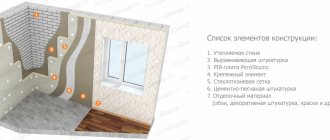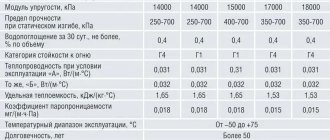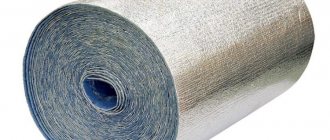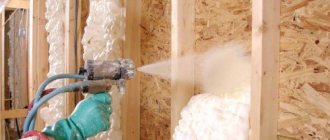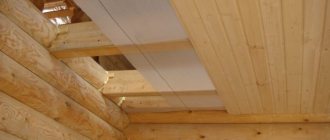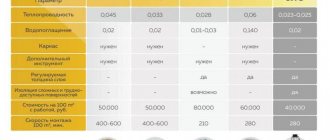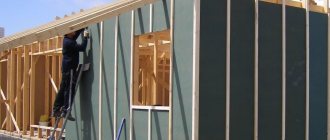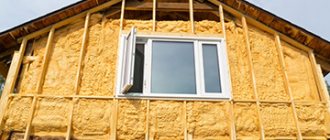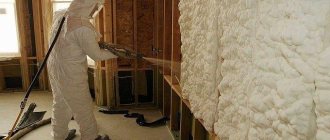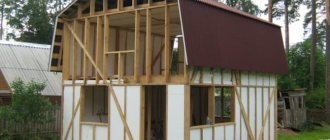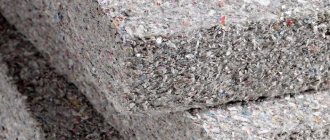Features of materials
The finest fibers of the material are held together using absolutely safe substances, which can be of synthetic (polyester) or natural (starch) origin. For more than ten years, such insulation materials have been produced all over the world, including Russia. In addition to environmental safety, they have a number of significant advantages. For example, their thermal conductivity and acoustic properties are not inferior to those of mineral wool, and in some cases even exceed it.
In addition, when choosing a particular material that performs the function of insulation, it is necessary to take into account that the effectiveness of insulation work depends not only on the degree of its thermal conductivity, but also on the quality of installation. And here an important role is played by the fact that the plant components at the plant are knocked together into dense, elastic mats or slabs that fit well to the wall, which means they eliminate the appearance of “cold bridges” and reduce heat loss. To take a closer look at the most popular thermal insulators for the home, let’s look at their characteristics in more detail.
Environmentally friendly insulation for the walls of a house, bathhouse
Preface .
Many owners of apartments and country houses, before insulating their premises themselves, are interested in one of the most important questions: which environmentally friendly thermal insulation to choose for finishing their house. Let's consider the current issue of choosing environmentally friendly insulation for a wooden house and bathhouse. We will describe the main characteristics and consider the pros and cons of the most environmentally friendly insulation materials. Photo. Insulating the basement of a house with penoplex
In winter, high-quality thermal insulation helps to significantly reduce heat loss at home. For a modern apartment in a large metropolis and for a wooden house outside the city, not only low thermal conductivity is important, but also the absence of harmful effects on human health. The safest thermal insulation today is considered to be: ecowool, natural insulation made from cotton and linen, as well as fiberglass and polyurethane foam.
The most popular, due to their low cost, polystyrene foam insulation is not safe because it emits carcinogenic substances - styrene. Therefore, extruded polystyrene foam and polystyrene should not be used for interior decoration in residential premises, but exclusively for thermal insulation of building structures from the street - insulation of strip foundations, facades and other building structures.
Hemp
The hemp plant itself has strong antiseptic properties, so pesticides are not used when growing it.
During operation, it does not rot or become moldy, and also protects the surface of the walls of the house from such misfortunes. The strength of the mats or slabs (up to 40 kg/m³) guarantees long-lasting service without shrinkage.
Scope of application
The plant material is universal and can be used for insulating roof structures, walls, floors, spans between floors, attic floors and frame houses. It is also used for soundproofing partitions. As you can see, hemp insulation is suitable for treating any places and structures, and its high cost is quickly offset by savings on heating and air conditioning.
Composition and form
Absolutely harmless to humans and animals, environmentally friendly hemp-based insulation for house walls consists of 85% natural fibers. To increase the fire resistance of the material, manufacturers add a fire retardant (soda) in an amount of 3 - 5% of the total mass of raw materials. The fibers are held together using polyester (10%). The form of release of such insulation is slabs and rolls, the thickness of which varies from 3 to 18 cm.
Standard sizes of hemp boards are 600x1200 mm, 625x1200 mm, 580x1200 mm and 1000x2400 mm. The following dimensions are relevant for rolls: width – 580, 600 or 625 mm, thickness – 30, 40, 50, 60 and 80 mm, length – 1200 or 2400 mm. In most cases, you can order material according to individual sizes.
Advantages
Vegetable heat insulator has many positive properties, and we will try to list them all. First of all, it has excellent thermal conductivity for a material of this purpose (0.038 - 0.04 W/m*K), which does not change in conditions of high humidity, which is impossible in the case of mineral wool analogues. Thanks to this advantage, you can do without additional vapor barrier. You can also note the high level of thermal inertia, thanks to which the house perfectly retains coolness inside in the summer and warmth in the cold season.
When installing natural insulation, the problem of sound insulation is also solved. Hemp insulation is made from renewable raw materials. They are environmentally friendly during disposal and have a positive effect on reducing CO2 emissions into the atmosphere. What is important for most developers is that the installation of rolls and slabs is very simple, since the material adheres tightly to the surface of walls and other structures.
It is impossible not to mention the possibility of using vegetable insulation when creating ventilation “breathing” facades.
Ecowool
Another name for ecowool is cellulose insulation. This fully characterizes the composition of the insulation, which includes 81% recycled wood raw materials, and the remaining 19% are fire retardants and antiseptics. The thermal conductivity of this material is at the level of 0.036 - 0.041 W/mK.
The main difference between ecowool and other insulation materials is the seamless method of applying it to the surface of the walls of the house, which means you don’t have to worry about the formation of “cold bridges”. Due to the low air permeability of the material, the movement of air flows through the fibers slows down, and heat transfer loses its intensity.
Advantages
Cellulose heat insulator is absolutely non-toxic. It does not contain carcinogens or harmful volatile fractions. Due to the light weight of the material, the scope of its application increases significantly, and by reducing the thickness of the walls, you can save up to 30% on construction. The same applies to savings on heating, which also reaches 30%. The special structure of ecowool allows it to penetrate into all crevices and hard-to-reach places.
For comparison, if we apply a 10 cm thick cellulose coating to the surface, we will get the same thermal insulation coefficient as a 55 cm foam concrete wall or 145 cm brickwork. Among other advantages, the most obvious are:
- protection of surfaces from corrosion;
- resistance to fungi and microorganisms;
- no shrinkage;
- ease of installation.
Fire safety
Separately, I would like to say about the fire safety of ecowool, since the requirements for this type of building materials are very high. All of them are divided into two categories: NG (non-flammable) and G (flammable). Combustible materials are classified into four groups (G1, G2, G3, G4). The division into categories is carried out according to four criteria:
- Temperature indicators of flue gases.
- Degree of damage (length).
- Degree of damage (mass).
- Self-combustion time.
Ecowool belongs to class G1, which is quite good. During testing, a flame from a burner is directed onto a mound of cellulose insulation, and it does not flare up, even though it is made of paper. This can be achieved thanks to fire retardants, which release moisture from molecules, which, in turn, prevents fire from spreading. Also, during combustion, cellulose insulation produces less smoke compared to PVC materials, and it also contains carbon dioxide, which suppresses the combustion process.
Scope of application
Due to its environmental friendliness, cellulose heat insulation can be used everywhere, from residential buildings to healthcare organizations. It adheres perfectly to walls, roofs and floors made of metal, brick, foam concrete and other building materials.
Linen
A worthy insulation for wooden houses made of logs and timber is flax-based material, which is placed between the crowns, thereby preventing the penetration of cold and the process of rotting at the joints of the wood. For such work, tapes and felt are most often used.
Plates, rolls and mats can be mounted on any surface in buildings for various purposes, as they are absolutely harmless.
Types of insulation
Eco-friendly linen insulation is divided into several types:
- linen slabs;
- tape felt;
- flax tow;
- flax-jute.
All these forms of material release do not accumulate moisture, speed up the process of erecting wooden buildings and are easy to install.
In the production of linen boards, just like hemp boards, polyester or natural binders are used.
In most cases, manufacturers fireproof the material using borax (salt). Mats and slabs made from flax raw materials have a high heat capacity.
Specifications
The density of linen boards varies between 20 – 34 kg/m3. The thermal conductivity coefficient is at the level of 0.038 W/mK, and the vapor permeability coefficient is 0.4 mg/m h Pa. The sound absorption indicator reaches 0.98. The average service life of insulation is at least 75 years.
Choosing environmentally friendly insulation for a bath
Moss is a traditional bath insulation
Today, like decades ago, materials based on environmentally friendly raw materials - moss and jute - are used for inter-crown insulation and caulking of bathhouse logs. Jute inter-crown insulation for log houses is more convenient to use; it is suitable not only for insulating the dressing room from the inside, but also for wooden houses made of rounded logs. When assembling a log house, a roll of insulation is evenly laid out along the length of the crown and a log is placed on top of it.
Related article: Calculation of a metal lintel for load-bearing walls
Traditional, environmentally friendly insulation for a bathhouse ceiling is a mixture of sawdust with clay or earth. This “old-fashioned” method of ceiling insulation is not only the most inexpensive, but also the most effective. In addition, such ceiling insulation will not prevent the bathhouse from “breathing.” Another traditional bulk insulation for horizontal surfaces is expanded clay, made by firing ordinary clay at high temperatures.
Installation process
We have already managed to study the features and characteristics that environmentally friendly insulation materials have; it remains to consider the method of installing them on the surfaces being treated. The installation of rolls, slabs and mats made from plant components is no different from the installation of mineral wool.
Preparation
At the first stage, the surface is prepared by removing old sheathing and insulation elements. It is better to plaster large chips and defects.
It is also necessary to clean the walls from dirt and dust. Now you can begin the main work.
Lathing
For the best effect, it is necessary to install a slatted frame made of wooden planks or metal profiles on the external walls of the facade. The thickness of the sheathing should correspond to the thickness of the insulation. The step between the frame elements is marked taking into account the sizes of the slabs or insulation rolls.
Laying the material
Mats or slabs of vegetable insulation are placed tightly and without gaps between the guide rails, starting from the bottom. A cladding is installed on top of the insulation. If the attic space is being treated, the material is placed between the rafters.
Environmentally friendly insulation for interior work
The most popular environmentally friendly insulation for indoor walls and ceilings are mineral wool slabs and mats, since they are made from rocks. The most inexpensive and easiest to install environmentally friendly floor insulation is foamed polyurethane foam (penoizol or penofol). A more expensive option for healthy insulation is ecowool, made from recycled waste paper.
We looked at the pros and cons of the most environmentally friendly insulation materials: basalt wool, fiberglass, ecowool, sprayed polyurethane foam (PPU) and others. You learned about possible difficulties during the installation and operation of these materials, as well as about the advantages of using the considered heat insulators. This information will help you choose the best option for decorating your home.
Application of cellulose insulation
There are two methods of cellulose insulation: “dry” and “wet”. It is better to insulate inclined surfaces and floors using the first option. A hole is cut in closed cavities and, using special equipment, ecowool is blown into the structure. You can also carry out the process by hand, without the use of special equipment. To do this, it is enough to scatter the material over the surface to be treated, compacting it if necessary.
Wet installation of ecowool is suitable for walls equipped with a frame. The material is moistened with water and blown onto a plane to which it will stick very well and create an insulating layer. Excess material must be cut off with a special roller.
This is how you can simply and effortlessly insulate your home using safe and environmentally friendly materials, thereby maintaining a healthy indoor microclimate. The correct choice of insulation and proper installation will help solve the problem of energy saving for many years.
How to insulate the walls of a house from the inside: choosing internal insulation
When living conditions in a country house cease to be comfortable, urgent measures must be taken. This primarily concerns lowering the air temperature inside. If the building freezes, thermal insulation work will have to be carried out.
Insulating walls from the inside is not very welcome by modern professionals, but sometimes it is impossible to do this from the outside. In order to be satisfied with their own work and not doubt the durability of the thermal insulation of the house, novice builders need to buy high-quality material, wisely prepare the structure, and also comply with a number of requirements during the installation process.
Related article: How to fix insulation on a wooden wall
